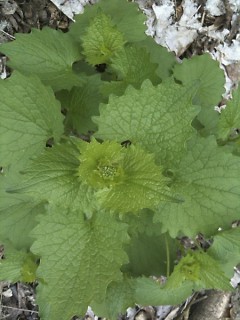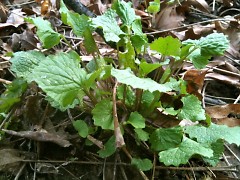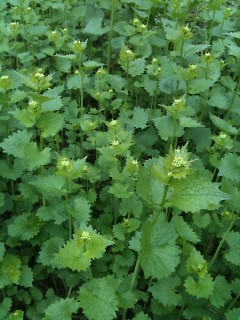What is the adage, "A weed is a plant that is growing where you don't want it?"
Abundant in areas of disturbed soil - at the forest's edge, along roadsides, and on river floodplains, the garlic mustard (Alliaria petiolata) is deemed by conservationist organizations like The Land Conservancy to be more that a noxious "weed," but an invasive species -choking out native vegetation and spreading wildly across the state.
The National Park Service describes the earliest appearance of garlic mustard on record was in Long Island, NY in 1868. It is believed that it was brought along by settlers to the area of Long Island, NY for food and medicinal purposes.
Since that time in the 1800s, garlic mustard has spread south and west and has wreacked havoc on natural areas throughout the Eastern United States; particularly throughout fields, floodplains, and woodlands here in the Great Lakes bioregion.
What makes garlic mustard able to take over so much area in so little time? Garlic mustard thrives on spreading through areas of disturbed land and areas under development. It is winter hardy and can reproduce lightning fast with its ability to produce hundreds of seeds once it goes to seed. And once the plant sets its seed, the seeds can remain viable in the soil for many years.
Blandford Nature Center hosts "pull" to preserve native habitats
In Michigan, the Land Conservancy has worked diligently with partner agencies to engage the public in garlic mustard "pulls" to help maintain Michigan's native plant populations. One local partner in the Land Conservancy's statewide effort is the Blandford Nature Center. This 143-acre ecological jewel in the middle of Grand Rapids has had a variety of habitats that have been invaded by the garlic mustard.
On Saturday, April 30, Blandford is hosting a day-long garlic mustard pull and is inviting the public out to lend a hand. This event will help keep this plant from crowding out the wildflowers and other vegetation that live in the wooded areas, on the trails, along the powerlines and in the meadows. The event will be held from 10-4 p.m. and volunteers are asked to bring gloves, water and a lunch. Light snacks made from the garlic mustard will be provided by volunteers.
The Executive Director of Blandford Nature Center, Annoesjka Steinman explains that the center has been struggling with the invasive nature of the garlic mustard for several years. "We've had concentrated pulls for the last three years and have seen a significant decrease in colonies. Improvement is being made thanks to help from volunteers."
Can't attend a community pull? Residents at home can also support the efforts of the Land Conservancy and the center by keeping an eye out for the garlic mustard and pulling it out at the root before it goes to seed. Composting the plant will not destroy the seed and they can remain viable for many years, so it is most beneficial to remove the plant early in its growth.
Behind every vice… the garlic mustard's virtue
And while garlic mustard continues to persist throughout our Great Lakes bioregion and threatens to crowd out wildflowers and native vegetation, we can consider one of its virtues: It is edible!
Like many early spring greens, the flavors of the garlic mustard are predominantly bitter. Different parts of the plant, as well the age of the plant, can affect the degree in the bitter flavor.
Great Lakes Herbalist Jim McDonald believes that the bitter flavors of plants, while having a negative connotation to many, may be one of the keys to our wellness. Bitter flavors help stimulate digestion, bile production and can support healthy liver function. Other bitter plants that are beneficial to add into the diet include parsley, arugula, romaine, radicchio, endive, dandelion, and coffee. Best thing about garlic mustard: it's a bitter and it can be easily harvested for free with little concern of damaging its plant population!
Forager and wild food expert Steve Brill explains early basal roots are more bitter in the spring, the fleshy stems less so - and it is sweeter in the fall after a frost. The roots are slightly nutty, and the second year plant should be harvested just before it flower. But don't get caught up in these rules: if you are pulling it to preserve other plants in your garden or participating in a pull, use it and partner it with other flavors like parsley, walnuts and lemon to suit your palate!
One of the most popular ways to prepare garlic mustard is preparing it as a versatile, delicious pesto. Variations on pesto recipes can vary to suit personal taste preference and the flavor of the garlic mustard that is being harvested.
Want to prepare a large batch? Pesto can be made without the nuts (they tend to taste rancid after thawing) and froze into ice-cube sized portions that will last for several months until the local basil is ready for harvest here in Michigan.
Need ideas for uses of the garlic mustard pesto? The pesto can be added to pasta, used in soups (like a French soup au pistou), served on crackers with cheese as an elegant appetizer, or even used as a base for a wild foods pizza of local Michigan morels, homemade soft cheese, and wild onion.
The Rapidian, a program of the 501(c)3 nonprofit Community Media Center, relies on the community’s support to help cover the cost of training reporters and publishing content.
We need your help.
If each of our readers and content creators who values this community platform help support its creation and maintenance, The Rapidian can continue to educate and facilitate a conversation around issues for years to come.
Please support The Rapidian and make a contribution today.



